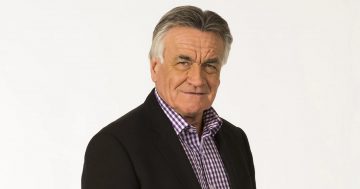
Old Parliament House, is home to MoAD. Photo: Michelle Kroll.
The Museum of Australian Democracy (MoAD) will reopen, albeit without its iconic front doors, on 28 April after being closed following a devastating fire on 30 December last year.
The fire caused significant damage throughout the building and the team has been working hard to restore it since.
MoAD director Daryl Karp said it was an understatement to describe the re-opening as pleasing.
“It’s wonderful for us to be able to reopen the doors but having said that, we’re not opening the front doors. The front doors won’t be ready until around July,” Ms Karp said.
The fire caused damage on three levels, according to Ms Karp. The first was the obvious damage to the front doors and portico, which was destroyed. The second was the burst step tiles caused by the fire’s heat.
“We had to strip that whole area back down to the 1927 brick and the good news is we will be able to fully fix any leaks because, according to the heritage conservators, it’s been leaking since 1927,” Ms Karp said.
The third level of damage was the “thick soot layer” across the heritage fabric of many of the exhibitions, chambers, the King’s Hall and other rooms of the building – a combination of smoke, accelerant, water and everything used to put out the fire.
“Whilst in most places smoke and soot is not an issue, in a museum, it’s an incredibly problematic and often corrosive layer to have on objects like statues and wood,” Ms Karp said.
MoAD staff used the closure as an opportunity to better understand how the building was built and how best to preserve it.
“With the front steps, the layers and how we were able to understand how it was built right down to the 1927 layer and then taking it back to where it was, dare I say it, it’s even better than where it was,” Ms Karp said.
“[On] the downstairs floors on the lower level, particularly where the Behind the Lines (annual exhibition) Canberra visitors would go, is actually the traditional 1927 rubber and that really took the brunt of the fire extinguishers and water.
“In cleaning it, we’ve discovered that it’s actually no longer rubber and more pressed powder because it’s so old and it’s been walked on for so long.”
They’ve also attempted to make the experience at MoAD even better, including a new exhibition with “family activities”.
“We’ve taken the opportunity to not only do a full spring-clean but also to develop new fabulous, timely exhibitions as democracy around the world is under a bit of an assault,” Ms Karp said.
Her pride in what they’ve been able to do at MoAD in the time since its closure is in stark contrast to the “devastation” she felt upon the building’s assault and forced closure.
“It was just that sheer sense that this extraordinary building that represents all that is positive about Australia’s openness of democracy, the systems, the fact that we welcome and engage with people as they come into the building, to then have it closed for this period of time, has been really, really disheartening,” she said.
To coincide with MoAD’s reopening, organisers announced five former prime ministers as official patrons of the museum: John Howard, Kevin Rudd, Julia Gillard, Tony Abbott and Malcolm Turnbull.
John Howard said he was proud to become a MoAD patron.
“It is essential for any vibrant democracy to have institutions that not only remind us of our history, but also interrogate it so that each successive generation can learn the lessons that will help them achieve a more just and more prosperous future for all,” Mr Howard said.
“The Museum of Democracy at Old Parliament House is one such institution.”
More information about upcoming new, permanent exhibitions is coming soon. MoAD will also become a national voting booth again for anyone from anywhere in Australia to vote at the Federal election.





















